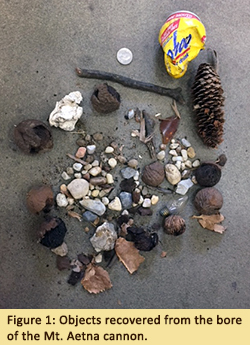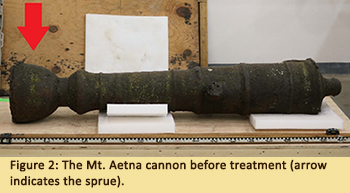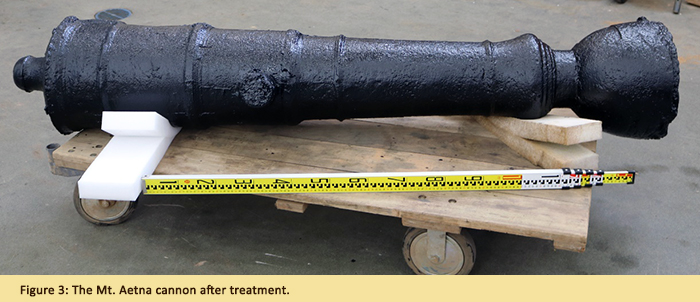Curator's Choice 2018
The Curious Inner Lives of Cannons
August 2018
By Heather Rardin, MAC Lab Conservator
 Earlier this year, the MAC Lab was asked to treat two cannons for the Jamestown-Yorktown Foundation and the National Park Service. One cannon, forged in the Mt. Aetna Furnace of Washington County, Maryland in the latter half of the 18th century, yielded some odd discoveries during treatment.
Earlier this year, the MAC Lab was asked to treat two cannons for the Jamestown-Yorktown Foundation and the National Park Service. One cannon, forged in the Mt. Aetna Furnace of Washington County, Maryland in the latter half of the 18th century, yielded some odd discoveries during treatment.
If this cannon had been previously fired, we would have first utilized x-radiography to peer inside the bore and check for powder and projectiles that might still be present.
However, we know from one key feature that the Mt. Aetna cannon was never fired; in fact, it was never even finished. This is evident from the presence of a sprue at the end of the muzzle (see Figure 2). A sprue is a conically-shaped attachment that is a product of the casting process. In the 18th century, a cast would have first been fashioned from loam, baked, and then assembled vertically with the breech end at the bottom. A funnel-shaped cavity at the top fed the molten metal down into the mold, thus creating the sprue that we see on the Mt. Aetna cannon. During the finishing process, the sprue would have been sawn off (Callegari 1994:56).
After cleaning the exterior of the cannon by abrasion using ground walnut shells, we had to change tactics in order to clean the interior. We needed to delve deep into the bore to remove dirt and other objects that might have been lodged inside of it, and we modified some of our favorite hand tools in order to accomplish this. With some difficulty, we removed an assortment of natural debris and modern items (see Figure 1). These included broken glass, a lightbulb, stones, dried plant matter, a Yoohoo can, and a 1978 quarter. Tour groups visiting the lab during this time found these items to be a somewhat amusing assemblage.
 The items that we found inside the Mt. Aetna cannon were not unlike langrage, a term used to describe a mixture of small, sharp impromptu projectiles that soldiers and sailors might ram into the cannon, and fire at an enemy. Langrage might include broken glass, small pieces of shot, bolts and other small pieces of hardware such as nails (Wilde-Ramsing and Carnes-McNaughton 2018:105). Such improvised weapons have been recovered from the bores of excavated cannons, including those from the wreck of the Queen Anne’s Revenge, the infamous flagship of the pirate Blackbeard (Page 2018).
The items that we found inside the Mt. Aetna cannon were not unlike langrage, a term used to describe a mixture of small, sharp impromptu projectiles that soldiers and sailors might ram into the cannon, and fire at an enemy. Langrage might include broken glass, small pieces of shot, bolts and other small pieces of hardware such as nails (Wilde-Ramsing and Carnes-McNaughton 2018:105). Such improvised weapons have been recovered from the bores of excavated cannons, including those from the wreck of the Queen Anne’s Revenge, the infamous flagship of the pirate Blackbeard (Page 2018).
After we applied protective coatings to it, the Mt. Aetna cannon journeyed down to the American Revolution Museum at Yorktown, where it is currently on display. As much as we were entertained by the strange debris inside the cannon, we hope that future generations won’t leave us with the task of removing such items from this cannon in the years to come.

| References |
|
| Callegari, Dennis |
| 1994 |
Cook’s Cannon and Anchor: The Recovery and Conservation of Relics from HMB Endeavour. Kangaroo Press Pty Ltd. |
|
| Page, Courtney |
| 2018 |
"Langrage." Queen Anne’s Revenge Project, Natural and Cultural Resources. https://www.qaronline.org/conservation/artifacts/arms-and-armament/langrage. Accessed 17 July 2018. |
|
| Wilde-Ramsing, Mark U. and Carnes-McNaughton, Linda F. |
| 2018 |
Blackbeard’s Sunken Prize: The 300-Year Voyage of Queen Anne's Revenge. The University of North Carolina Press, 2018. |
|